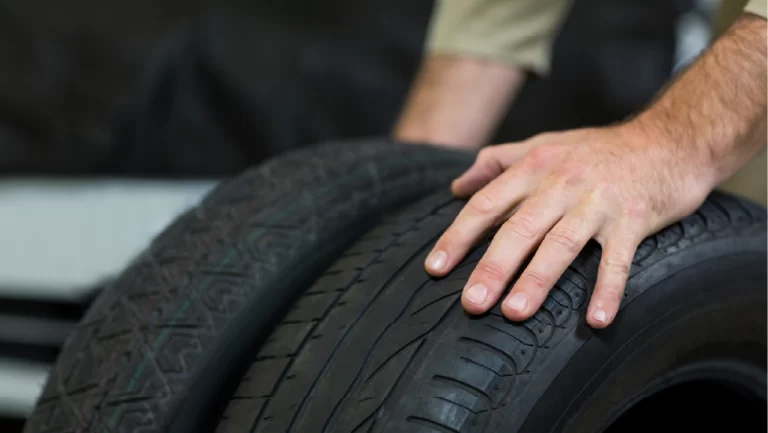In the rubber industry, every component of a high-performance tire plays a specific role in ensuring safety, durability, and efficiency. One of these key elements is the chafer. This technical fabric, located in the bead area of heavy-duty tires, reinforces the tire’s structure, protecting it from wear caused by contact with the rim and extending its lifespan.
But how is the chafer made? In this article, we’ll explore the full process, from fiber selection to its integration into the tire, highlighting the importance of this component.
The role of the chafer
Before diving into its manufacturing process, it’s important to understand exactly what the chafer is and why it’s so relevant.
The chafer is a special technical fabric used in the production of heavy-duty tires, specifically designed to protect the tire’s sidewall.
Its functions include:
- Protecting the bead wires from mechanical damage.
- Preventing wear from friction during mounting and dismounting of the tire.
- Extending tire lifespan,especially under demanding working conditions.
Thanks to these properties, the chafer is essential in the production of industrial and agricultural tires, in other words, in high-performance tires.
In the rubber industry, this material is considered a strategic element to ensure both safety and performance in heavy-duty tires.
Fiber selection for the chafer
The chafer manufacturing process begins with the selection of fibers, as the final properties of the fabric depend on them. The fibers most commonly used in rubber industry are:
- Nylon 6 and Nylon 66: for excellent tensile strength and abrasion resistance.
- Polyester: ideal for applications requiring dimensional stability and lower elongation.
- Aramid: a high-performance fiber offering extreme strength and lightness.
- Hybrid fibers: combining several of the above to balance strength, flexibility, and cost.
Each fiber type is chosen based on the specific needs of the tire.
Spinning process
Once fibers are selected, the spinning process begins,, que consiste en transforming raw material into uniform, durable yarns. This step is critical because yarn quality largely determines the performance of the final fabric.
Spinning includes:
- Drawing the fibers to align them and increase strength.
- Controlled twisting to improve cohesion and stability.
- Surface treatments, such as resins or adhesion agents, to improve bonding between yarn and rubber during vulcanization.
In the rubber industry, quality control at this stage is strict, since any irregularity in the yarn could compromise the performance of both the chafer and the tire.
Weaving: shaping the chafer
With the yarns ready, the next step is weaving. This process turns yarn into either a flat or tubular fabric, depending on the tire manufacturer’s design.
The most common technologies are:
- Plain weave: ideal for car and motorcycle tires.
- Bias weave: more resistant to wear, perfect for industrial and heavy machinery tires.
The weave pattern is carefully chosen to ensure:
- High resistance to friction.
- Enough flexibility to adapt to the tire bead.
- Compatibility with later coating and vulcanization processes.
This weaving stage is one of the most important in the rubber industry, as it defines the final product’s quality and performance.
Treatments and coatings
Once woven, the chafer undergoes Once woven, the chafer undergoesthat add extra features and prepare it for integration into the tire. These may include:
- Adhesive resins that improve bonding with rubber.
- Special coatings to increase abrasion resistance.
- Thermal stabilizationto ensure the fabric maintains its properties during vulcanization, where it is exposed to high temperatures.
Thanks to these treatments, the chafer becomes a highly reliable, durable material capable of withstanding extreme working conditions in the rubber industry.
Quality control
Quality is a cornerstone in chafer manufacturing. Each batch undergoes rigorous testing, including:
- Tensile and elongation tests,to ensure the fabric withstands expected stresses.
- Adhesion tests, confirming proper bonding with the rubber compound.
- Abrasion resistance tests,measuring its ability to endure continuous wear.
In the rubber industry, these controls ensure that every meter of chafer meets international safety and performance standards.
Integrating the chafer into the tire
With the chafer completed and validated, it’s time to integrate it into tire production. This happens in the early assembly stages, when the basic tire structure is built.
The chafer is placed around the bead, reinforcing the contact area with the rim. Then, during vulcanization, the fabric fuses with the rubber, creating a solid, durable bond.
The result is a safer, longer-lasting tire capable of withstanding constant use in industrial applications. This integration is one of the most critical steps in the rubber industry.
Innovation in chafer manufacturing
Technology in the rubber industry never stops advancing. In recent years, chafer development has incorporated innovations to improve performance and sustainability, such as:
- Recycled fibers that maintain strength while reducing environmental impact.
- Ultra-light aramid yarns offering greater strength with less weight.
- More efficient production processesthat optimize energy and water use.
These advancements make it possible to produce more durable, eco-friendly tires that meet the demands of today’s global market.
The chafer, though invisible to the end user, is a critical component in the rubber industryFrom fiber selection to tire integration, every stage of its manufacturing process is designed to ensure strength, durability, and safety.
Understanding this process not only highlights the technological complexity behind heavy-duty tires but also shows why choosing high-quality materials makes all the difference in performance and safety.
The rubber industry will continue innovating in chafer development, driving more efficient and sustainable solutions forward.



